Churchill Wild pioneered polar bear walking safaris over 30 years ago, but our family has actually been working on the ground with polar bears for five decades. We operate the only lodge-based polar bear walking safaris on the planet, and they have become successful for a number of reasons, with the safety of both guests and polar bears being paramount.
Our polar bear safety protocols have been developed and refined over the course of almost 50 years; our lodges are located deep in the heart of polar bear territory, far from any outside influences or uncontrolled man-made attractants; and our guides are among the best in the world.
When we first started our walking safaris, we had only one paying guest. Since then, over 8,000 guests have experienced the incredible adventure of meeting a polar bear at ground level at one of our three luxury ecolodges on the Hudson Bay coast, two of which were original members of the prestigious National Geographic Unique Lodges of the World collection.
Churchill Wild has won numerous national and international tourism awards for excellence, Mike and Jeanne Reimer have been elected to the Royal Canadian Geographical Society’s College of Fellows, and guests have become loyal and emotional evangelists not just for Churchill Wild, but also for the polar bears and their fragile Arctic environment.
Increasing awareness of the Arctic environment and its wild creatures has always been one of our major goals at Churchill Wild, and in addition to our cherished guests, we are very grateful for the hundreds of members of the media, professional photographers and filmmakers who have helped us take this important message to the world.
On-the-Ground Experience with Polar Bears and Advanced Guide Training
Fifty years of experience have provided us with tremendous insights into polar bear behaviour, and these insights have been invaluable in establishing safety protocols for working with — and walking with — the world’s largest land predator.
All Churchill Wild lead guides have at least 10 years experience working with polar bears in the wild, and most of our guides have many more years of bear guiding experience with grizzlies, black bears and brown bears.
Additionally, all Churchill Wild guides have completed the Bear Guard Training Course offered by Andy McMullen’s Bearwise, which is recognized by Parks Canada, the Government of Nunavut, and the World Wildlife Fund Canada (WWF).
The Bear Guard Training Course was put on years ago in Churchill at a polar bear conference sponsored by the WWF. The conference was about human and polar bear conflict management and was attended by the governments of Manitoba and Nunavut, representatives from Greenland and a number of Inuit communities. Thirty guides went through the course. Ten of our Churchill Wild guides were taken aside for more advanced learning and also trained in how to teach the course.
A number of Churchill Wild’s guides have also completed the bear guiding course offered by the Commercial Bear Viewing Association of British Columbia, and all have firearms certification, along with the highest levels of first-aid training available. Additional certifications held by Churchill Wild guides include but are not limited to radio operations, commercial boating, kayaking and swift water rescue.
Churchill Wild guides have the best training currently available. There are no standards at this point for what we are doing, but we’ve been working to help set them. We’re blending our own experience with government guidelines, which are similar to those in the Commercial Bear Viewing Association guide course.
There may be only a handful of people in the world who have the level of experience working with polar bears that is held by Churchill Wild co-founder and owner Mike Reimer and the Churchill Wild guides.
The only people we know of with similar levels of experience are Churchill Wild’s first head guide and professional photographer Dennis Fast, polar bear researcher Nikita Ovsyanikov, who gave a course in Thompson a few years ago that two of our guides attended, and conservation officials in the polar bear inhabited regions of the world, especially those who operate the Polar Bear Alert Program in Churchill, which is overseen by the Sustainable Development department of the Manitoba government.
Safety in Numbers, A Three-Guide System
Churchill Wild uses a three-guide system, which means there are at least 30 years of bear guiding experience and more on the ground with the guests and the polar bears at all times. Two of the guides manage the interactions with the polar bears and the third guide works with the guests to ensure a safe and often exhilarating experience.
We talk to the guests about our understanding of polar bear behaviour, and about being in a safe-sized group. It’s very unlikely that we’re going to get approached by a bear, but if we do, we have noise and chemical deterrents, and we do everything we can to prevent an approach. It starts with group size and observation methods, voice, standing up to the animal, noise etc.
Professional wildlife guides and photographers agree that time spent with the animals and an intimate understanding of animal behaviour are the most important requirements for successful wildlife walking safaris, which have been in existence around the world for over 50 years.
Walking with polar bears in Canada, while rare and unique, is similar to other wildlife walking safaris that offer a more intimate connection with wildlife in their natural environment. And regardless of whether it’s lions and gorillas in Africa, tigers and snow leopards in India, grizzlies in Alaska, jaguars in Brazil, or polar bears in Canada, all walking tours require a heavy level of experience.
It really all comes down to experience and understanding animal behaviour. You have to spend time with the animals, analyze their behaviour, interpret what you’re seeing and act accordingly.
Polar Bear Safety Protocols Developed Over Decades
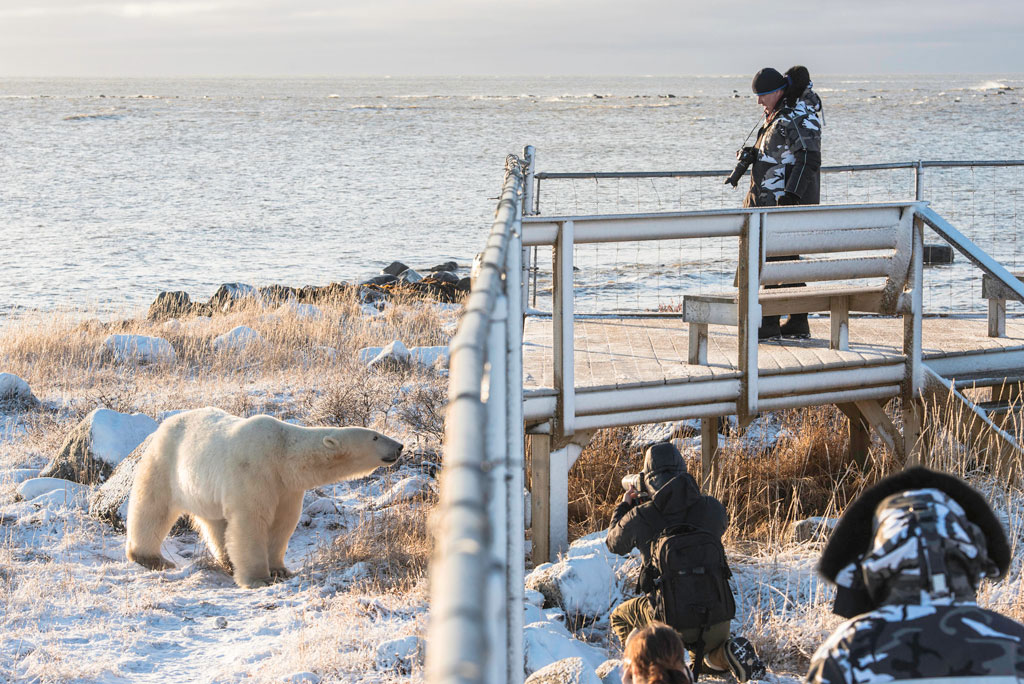
All Churchill Wild lodges have outdoor compounds surrounded by specialized fencing. Jad Davenport photo.
Mike Reimer first met polar bears at ground level while working as a guide for wife Jeanne’s parents Doug and Helen Webber at Dymond Lake Ecolodge in the 1980s. The Webber family had been dealing with polar bears at Dymond Lake since it was built in the early 1970s.
Located on the Mississippi and Atlantic flyways, Dymond Lake saw millions of geese, ducks and other migratory birds in the spring and fall, and this drew hunters from all over the world to the lodge. It also attracted polar bears.
“The hunters at Dymond Lake were shooting geese, and with birds lying around you were bound to get a lot of polar bears in the area,” said Reimer. “When we bought the Seal River property in 1993, we knew that you could safely be on the ground with the bears. We’d already been doing it for years.”
The dream at Seal River was to develop an ecotourism business starring polar bears and beluga whales, with a supporting cast of wolves, caribou, moose, wolverine, Arctic hare and fox, myriad birds and the beautiful flora of the subarctic, but Mike and Jeanne Reimer probably had no idea at the time that they were about to pioneer the world’s first polar bear walking safaris.
Mike Reimer was the original polar bear guide at Churchill Wild, and along with photographer Dennis Fast the duo began a lifelong journey with polar bears that very few people can match. Fast was Churchill Wild’s first full-time polar bear guide and chief wildlife photographer, and on-the-job training was required.
“During those early years, I was certainly intimidated,” said Fast. “You didn’t know what to expect. We learned more about polar bear behaviour every day. How they approached the lodge. Whether they were curious or planning trouble. I read more about them and applied whatever I could in the field.”
Always vigilant and never complacent, Reimer and Fast gained valuable experience daily through their interactions with the great white bears.
“We learned that they were very intelligent, curious and easily startled,” said Reimer. “And that they could generally be persuaded to leave without having to have any kind of aggressive encounter. You just had to be smart about it.”
Every bear was different, they all had their own personalities, and you had to interact differently with certain age classes, but common threads of behaviour were noticeable.
“Teenage bears were the most unpredictable,’” said Reimer. “Mothers and cubs were generally calmer, and a mother with newborn cubs was the safest bear you could find. She wanted nothing to do with any potential threat to her little cubs. She’d just leave and move the cubs off with her.”
Polar bear safety protocols were established based on experience and guests were briefed thoroughly before going out for a hike on the tundra in search of polar bears. They were told to always listen and respect direction from their guides, and to stay with their group at all times. These practices continue at Churchill Wild today.
In the early days, northern lodges in polar bear territory used bear boards — welcome mats and shutters with spikes in them — to make sure the guests and the lodges were protected from the polar bears, but those rudimentary methods are no longer used today.
All of the Churchill Wild lodges are now surrounded by buffalo fences — high-tensile wire fencing typically used for large animal enclosures — and the bears and wildlife do come right up to the fence. As an additional layer of protection, there is also electric fencing under the lodge windows, which are positioned high up off the ground. When out in the field with bears however, experience again means everything.
“The first line of defence is always to watch a bear’s body language,” said Reimer. “Our guides carry a variety of effective bear deterrents on the remote chance that an overly inquisitive bear approaches too closely, but we rarely have to use any of them. Our guides excel at being ‘bear smart’ and that is still our best management tool.”
Non-Intrusive Observers
People want to be on the ground with the animals, according to our guides, many of whom have participated in wildlife walking tours with rhinos, lions and other African wildlife, as have Churchill Wild photo leaders Jad Davenport and Charles Glatzer. All have an excellent understanding of animal behavior, which is required to help guests get the “perfect” photo.
“It’s a great way to interact with wildlife,” said Reimer. “On the ground at eye-level, in a safe and managed way. We go out in good-size groups and very rarely will a polar bear approach a large group. Polar bears don’t put themselves in a situation where they will get hurt. They’re very cautious, and they always assess a situation first. They’re far too intelligent to put themselves into any situation where they don’t have an advantage.”
Polar bears know that a single mistake could result in an injury that might affect their ability to hunt and survive, which is another reason Churchill Wild developed a set of strict rules and protocols to keep both the guests and the polar bears safe. Group size, experience watching the animals, knowing what’s going on in the area and how the bear might react, positioning and posture, can all be used to respectfully discourage a bear from coming closer, along with the additional noise and physical deterrents. We’re actually educating the bears NOT to get too close to people on foot, and that is a good thing.
Churchill Wild guides and guests respect the space of the polar bears and act as non-intrusive observers. They also do their best to ensure the bears do not become habituated to humans, which brings us to another of the main reasons why walking with polar bears at the Churchill Wild lodges works.
Lack of Outside Influences, Control Over Man-Made Attractants

Nanuk Polar Bear Lodge is located deep in the heart of polar bear territory, far from outside influences and uncontrolled attractants. Michael Poliza photo.
Churchill Wild operates in remote places far away from communities, so we have a good understanding and control over anything that might influence the bears, which is primarily food and smells. We’re in full control of what happens with man-made bear attractants such as oil, garbage, food and waste. Everything is managed. There has been some discussion about the habituation of bears to people, but the situation is very different in communities or in areas where hunting is commonplace. Think about what motivates a polar bear.
The town of Churchill, Manitoba has taken steps to control outside influences and attractants with an excellent polar bear management program that should be the model for all communities in polar bear inhabited regions. The program took many years to develop but has resulted in Churchill having very few incidents with polar bears. It has also allowed them to build a thriving polar bear tourism industry and become known worldwide as the Polar Bear Capital of the World.
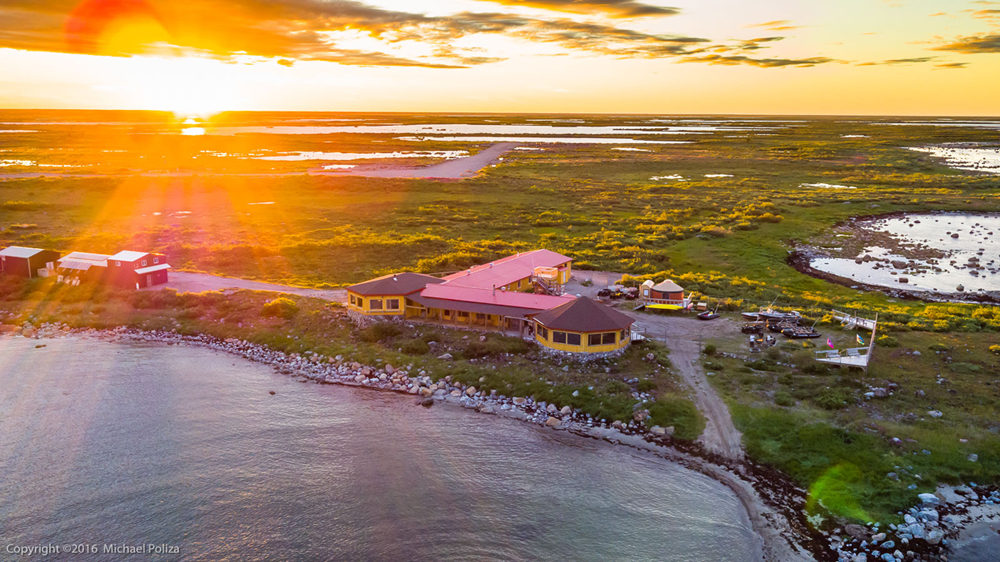
Seal River Heritage Lodge is located 60 km north of Churchill and is only accessible by boat or plane. Michael Poliza photo.
Managing outside influences and working with polar bears in and around communities, and in areas where hunting is a regular activity, is not the same as working with polar bears in remote locations, and may require a different set of guidelines and standards. Communities without polar bear management programs may also require additional government assistance and funding in the future to reduce the number of attractants and influences on the polar bears.
The government is advocating for polar bear guard certification, and we as a company, are trying to lead the way in levels of competence and set the standards for remote locations, no matter where they are in the world. We started an operations manual over 15 years ago. The Manitoba government sent us parameters and guidelines to follow, and most of them we were already following. We’re trying to act in a particular way, to work towards a polar bear certification standard, so that we’re all on the same page.
Guidelines may have to modified for communities dealing with polar bears, depending on attractants and influences. There are also more people doing polar bear viewing now, driving or walking on their own. They’ve taken a course and they’re now doing tours, but taking a course is not the same as experience. So we’re trying to set some standards, but it’s its going to be much tougher to manage in a community environment.
The Future of Polar Bear Tourism
The ultimate long-term goal is to get governments and all other stakeholders in the polar bear inhabited regions of Canada working together. Not only to establish standards for working with polar bears, but also to protect the bears and the communities they share the land with, and to increase awareness of polar bears and their environment through tourism, so that everyone including community members can benefit for generations to come. Teamwork, collaborations and partnerships will become even more important as major corporations start exploring development options in the Arctic.
Polar bear tourism works in different ways, on multiple levels, to increase awareness of polar bears and their environment, while also contributing to economic development and benefiting people in the surrounding communities.
Churchill Wild is proud of what we’ve accomplished, and of our long safety record, but we also know that there is much more work to be done, to ensure a successful future for everyone involved.
Including the polar bears.


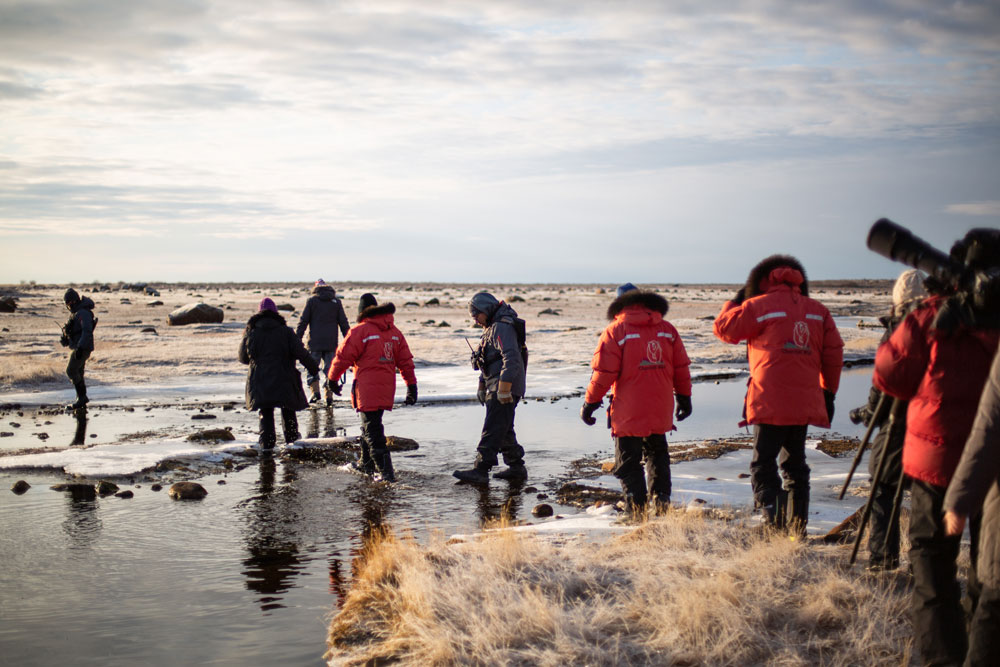
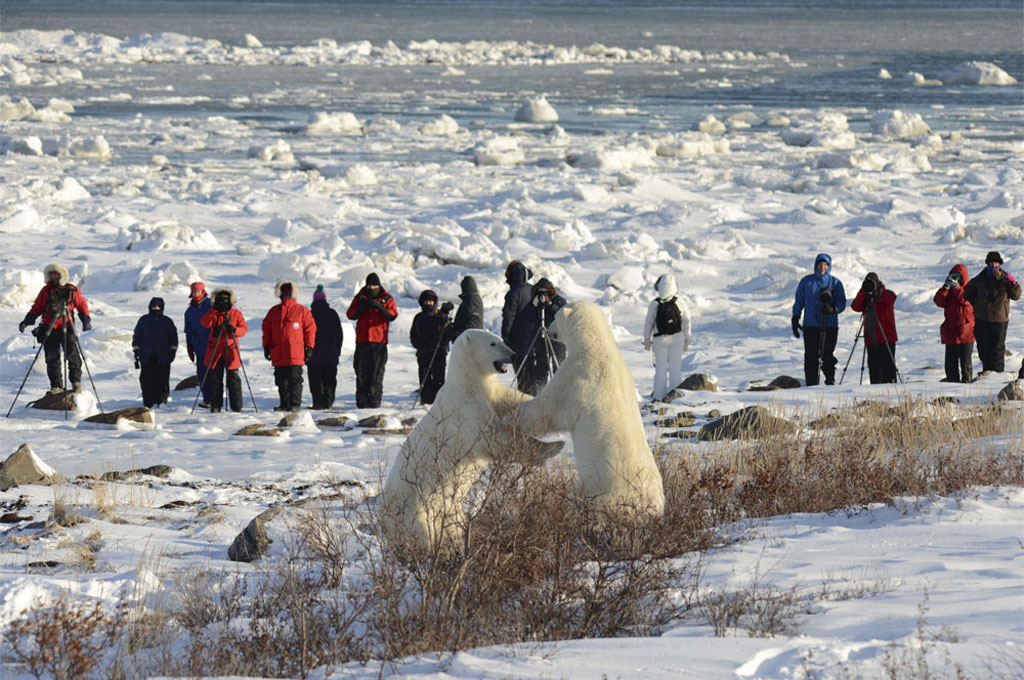
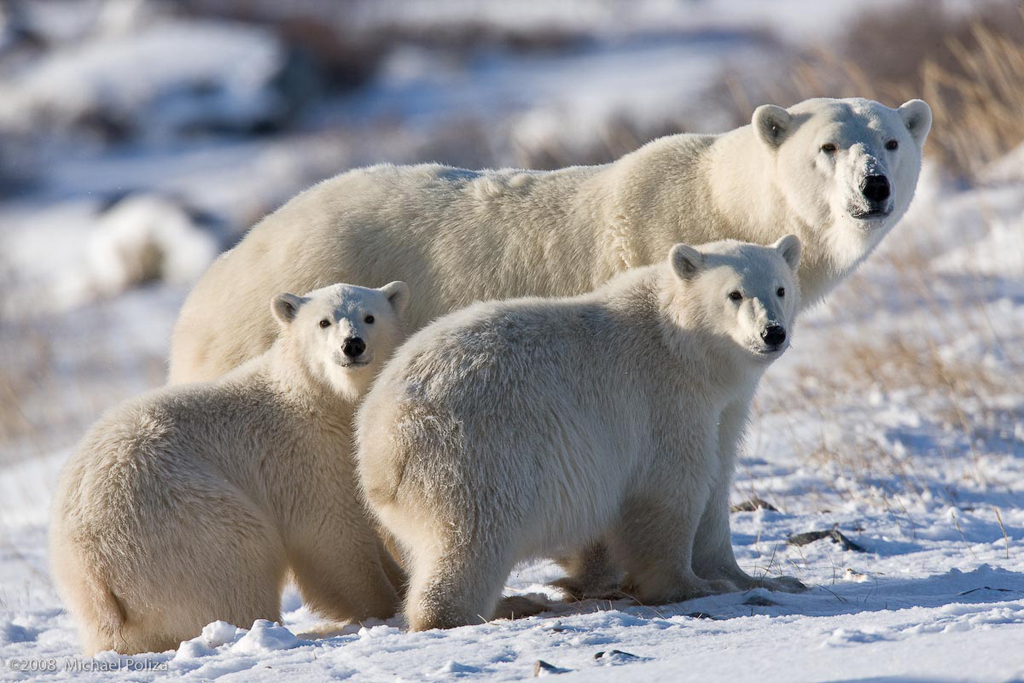
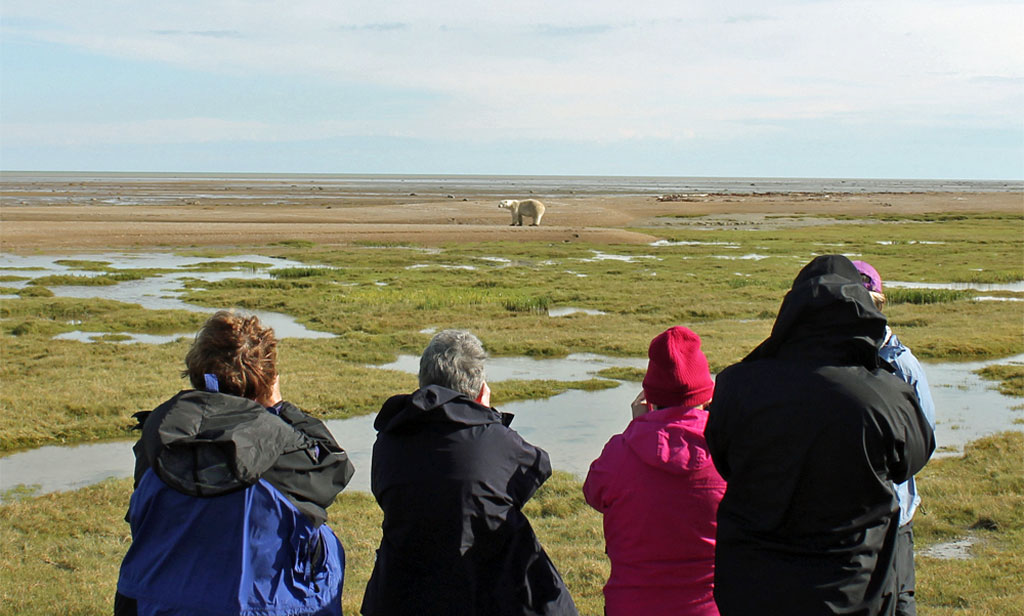
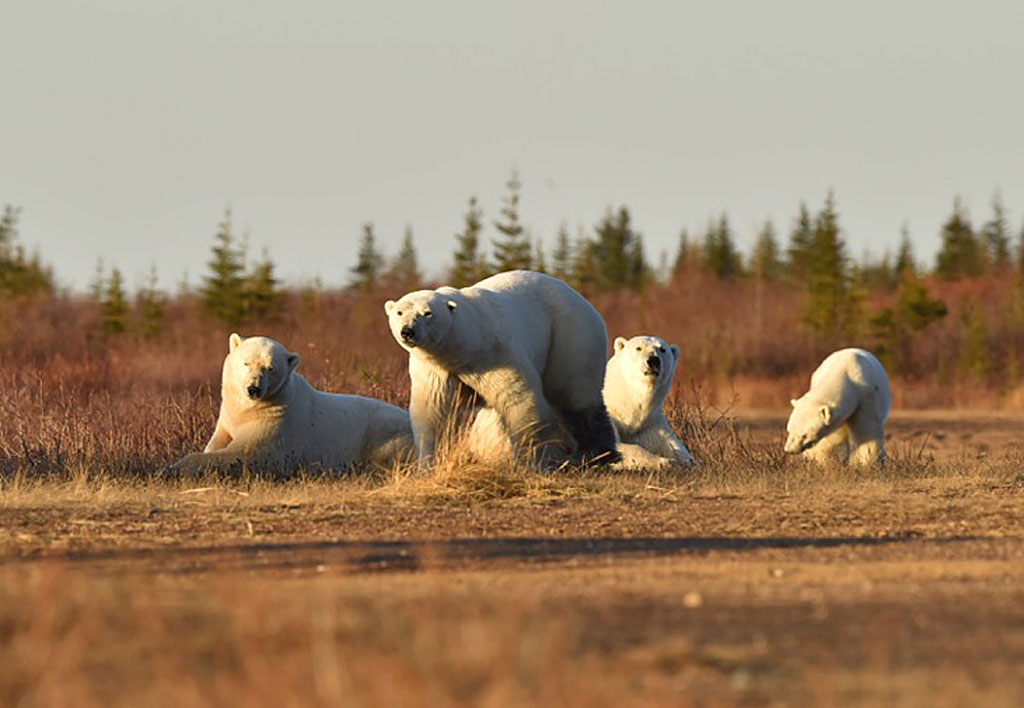
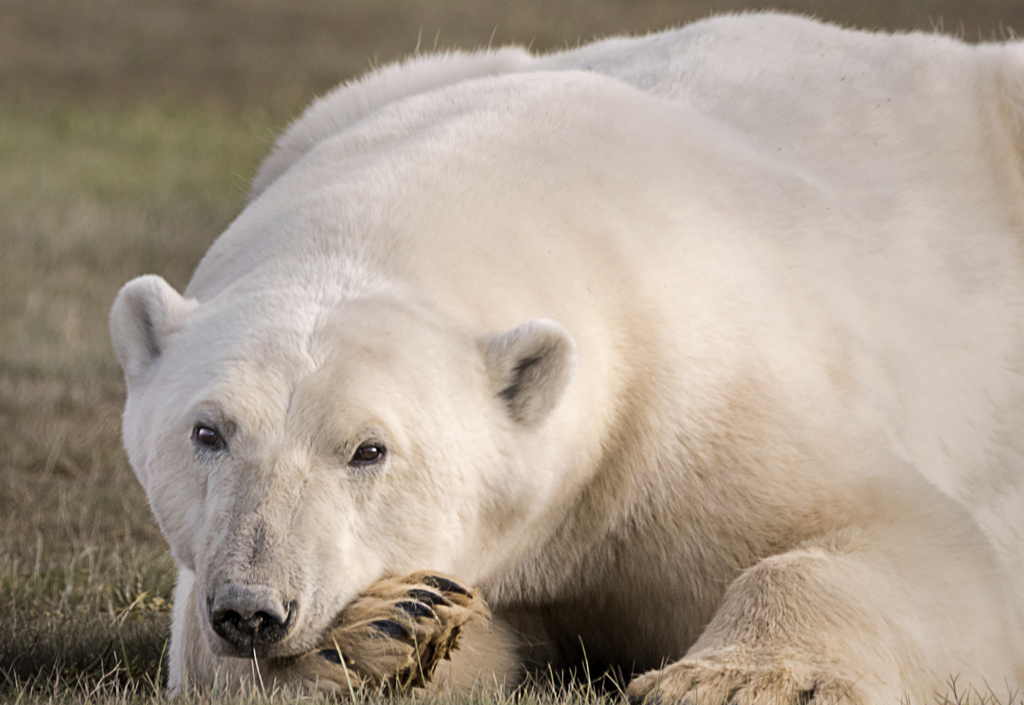








Hi,
We are interested in walking with the polar bears for summer 2025. We would like to know if the activity if kid friendly and a 5 year old is allowed in the tour.
Thank you
Kind regards
Hi Falguni, due to the physical nature of our safaris the minimum age for participants is eight years. Please realize that these are remote lodges where children will be expected to remain indoors when the group is not on outings. Your child must always be supervised (by you). Considerations for children under our minimum age are made on an individual basis. Please email us at info@churchillwild.com if you would like more information. Thank you for asking!